| Srl | Item |
| 1 |
ID:
191705
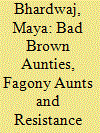

|
|
|
|
|
| Summary/Abstract |
This article offers an urgent complement to the trope of the South Asian aunty as an agent of discipline, shame, heteropatriarchy and tradition by exploring the counter-archetype of the resistance aunty—the radical feminist aunty who holds down social movements—in the South Asian diaspora. This article centres a queer lens on transgressive and activist aunties, and analyses digital and in-person queerings of the aunty in contemporary social and cultural movements. Examining resistance aunties in the writing, performances, interviews and other digital and in-person cultural work of four queer South Asians in the US and the UK, this article asserts the aunty as a core agent of resistance. It develops the notion of the resistance aunty in conversation with activist aunting in Black American organising and scholarship, and locates the legacy of the resistance aunty in queer and trans movements in the Global South and in the diaspora. By applying a new theoretics of resistance auntyhood to studies of aunty labour, this article argues for the importance of queer activist aunties in nurturing and propelling transformative social movements.
|
|
|
|
|
|
|
|
|
|
|
|
|
|
|
|
| 2 |
ID:
191711
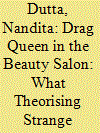

|
|
|
|
|
| Summary/Abstract |
LaWhore Vagistan, a South Asian drag queen, meets Noor, a South Asian beauty salon owner, in this essay to illustrate the kind of work diasporic aunties do for other migrant women. Aunties engage in aesthetic and emotional labour to build diasporic spaces of beauty and intimacy. The affective power of these spaces for migrant women and queer folks becomes legible at the intersections of gender, race and class. In this essay, I employ drag as a lens to understand the work of the diasporic beautician, putting into conversation two aunties who may seem antithetical to each other at first glance.
|
|
|
|
|
|
|
|
|
|
|
|
|
|
|
|
| 3 |
ID:
152263
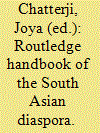

|
|
|
|
|
| Publication |
Oxon, Routledge, 2013.
|
| Description |
xv, 432p.: ill.hbk
|
| Standard Number |
9781138653252
|
|
|
|
|
|
|
|
|
|
|
|
Copies: C:1/I:0,R:1,Q:0
Circulation
| Accession# | Call# | Current Location | Status | Policy | Location |
| 059000 | 909.04914/CHA 059000 | Main | On Shelf | Reference books | |
|
|
|
|
| 4 |
ID:
061883
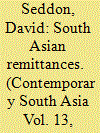

|
|
|
| 5 |
ID:
120710
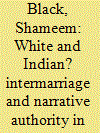

|
|
|
|
|
| Publication |
2013.
|
| Summary/Abstract |
How does intermarriage affect a storyteller? In this essay, I seek to examine literary narratives of South Asian family formation that take late twentieth-century intermarriages-particularly between Indian men and white American women-as their central governing trope. This phenomenon raises two linked questions: first, how do South Asian families recruit or reject individuals within constructs of South Asian identity; and second, to what extent do individuals not of South Asian descent gain the authority to imagine and re-imagine the contours of their multiracial family? I here examine the work of the white American writer Robbie Clipper Sethi, whose novel-in-stories, The Bride Wore Red (1996), tells the unfolding saga of a multiracial South Asian family in the United States and India. These narratives of white women socialised into ambivalent places within larger South Asian families, I argue, figure larger anxieties about imaginative representation across the mobile borders of what is considered one's culture. The family structure emerges as a contradictory space that empowers this border-crossing representational authority by simultaneously calling this authority into question.
|
|
|
|
|
|
|
|
|
|
|
|
|
|
|
|